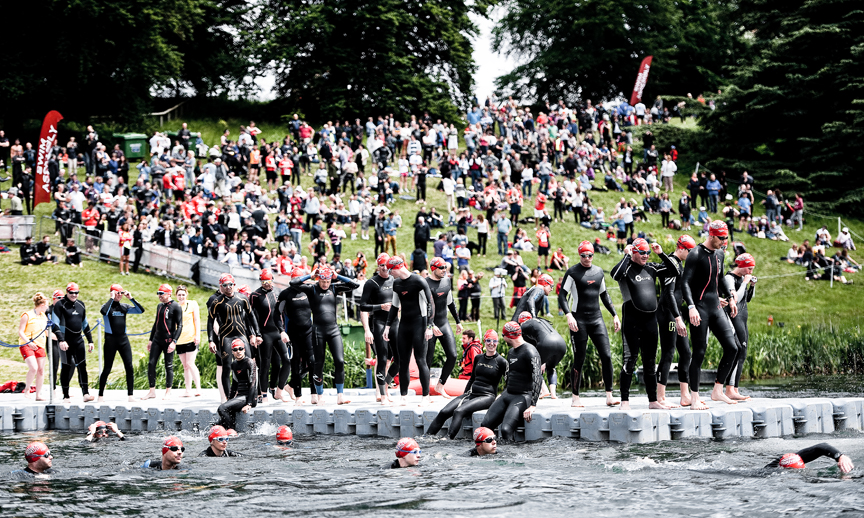Blenheim Palace Triathlon: Race info, tips and training advice
Want to know what to expect at one of the UK’s biggest triathlons? RG Active’s Phil Paterson has all the info you need to conquer the course

Since its first outing in 2005, the Blenheim Palace Triathlon has been a ‘must-do’ event on the UK tri scene.
Set against the majestic backdrop of Blenheim Palace, the race sees over 7,000 athletes traverse the historic grounds over the weekend for the super sprint- or sprint-distance races.
A major part of the attraction of the event is its stunning scenery, but the Blenheim Palace Triathlon also offers an inclusive and beginner-friendly route into triathlon.
With two different triathlon distances and the option of taking part alongside friends in a relay event, the Blenheim Palace Triathlon appeals both to newcomers and experienced triathletes.
When is the Blenheim Palace Triathlon?
The Blenheim Palace Triathlon takes place from 3-4 June 2023.
Where do the races take place?
The event is held at Blenheim Palace, Oxfordshire. It’s thought to be the only triathlon in the world, which takes place in the grounds of a UNESCO World Heritage site.
How many events are on offer?
There are four events to choose from:
Super sprint: 400m swim, 13.3km bike, 2.9km run
Sprint: 750m swim, 19.8km bike, 5.4km run
Sprint relay: 750m swim, 19.8km bike, 5.4km run (team of 2 or 3 people)
Weekend Warrior: The aim is to complete as many back-to-back (super-sprint or sprint) triathlons as you can in one weekend, see below for more information.
How does the Weekend Warrior event work?
Competitors complete the course that’s currently active. So, for example, the Blenheim schedule is Sprint first then Super Sprint second. If Weekend Warrior competitors go off during a Sprint wave, they do the Sprint course. Later in the day, they will do Super Sprints.
Athletes are informed when they get back to the swim start, and are also told the last time they can start a Sprint and the last time they can start a Super Sprint.
Competitors can only compete during competition hours only. They can set off no later than five minutes after the final wave of the day.
Most people who participate are seasoned athletes, but, of course, towards the end of day two some participants might alternate between running and walking.
What’s the Blenheim course like?

Top tips for racing Blenheim
The Blenheim Palace Triathlon begins with a lake swim so you’ll need to learn to use a wetsuit to your advantage. Because of the extra buoyancy in the suit’s hips and legs your kick becomes less about position in the water and more about propulsion.
In other words, you can relax more with your kick and focus on your technique and hip rotation.
Get some open-water swims in before race day and do some single-arm drills (see session 1, below) to help you dial in your rotation for bilateral breathing and also work on your sighting (see race session 2).
Blenheim’s bike course might not have any challenging climbs or tight technical sections but it can still catch you out. Cattle grids and lawns that run right up to the tarmac mean you need to pay attention while you’re flying around the course’s sweeping bends.
There’ll also be a very wide range of abilities out there, so take care when you’re overtaking other athletes.
To get you through the final run leg you’ll need good aerobic fitness but also the ability to change pace and work at different intensities. For that you’ll need to do some interval sessions (see session 3).
These are a really good way to develop a feel for pacing your effort so you can reel in any rivals or stay on track to post a new PB. Without that there’s a chance you might set off too hard and blow before you cross the finish.
Blenheim is a fast race so while fitness is key, there’s time to be saved in transition. As such, brick sessions (see session 4) are vital to ensure you can get your wetsuit off quickly and switch from cycling to running smoothly.
Training sessions

Session one
Single-arm drills develop your rotation for bilateral breathing. Swim 20 strokes using one arm with the other extended in front of you. Repeat with the other arm, then swim 100m freestyle. Repeat this four times.
Session two
Sighting helps keeps you on course. Swim two sets of 400-600m. Lift your head so just your eyes are above the water before turning your head to take a breath. Lifting your head any further will force your legs and hips down.
Session three
Warm up with 400m of jogging then do some stride-outs, side steps, high knees and heel kicks. Then do, 1.6km @ your 5km race pace; 2 x 800m @ your 5km race pace, with 35secs rest; 4 x 400m @ your 5km race pace, with 25secs rest.
Session four
Find a 5km bike route and a 1.5km run route somewhere you can set up a small transition area. Ride the route, then switch your gear to do the run. Do this 3-6 times until your bike mounts/dismounts and shoe changes are swift and smooth.
Top image credit: RB Create



